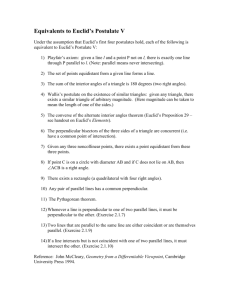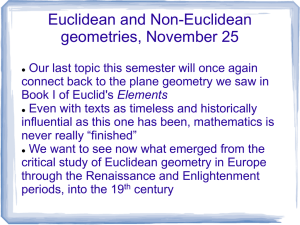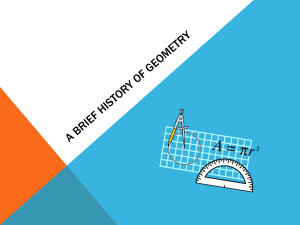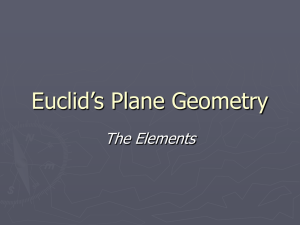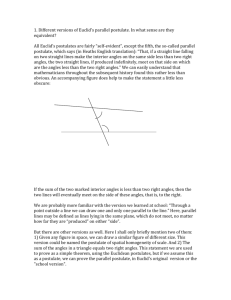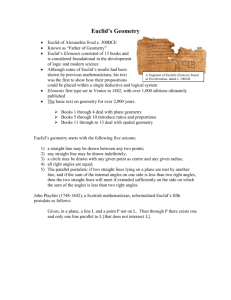Saccheri's great mistake
advertisement
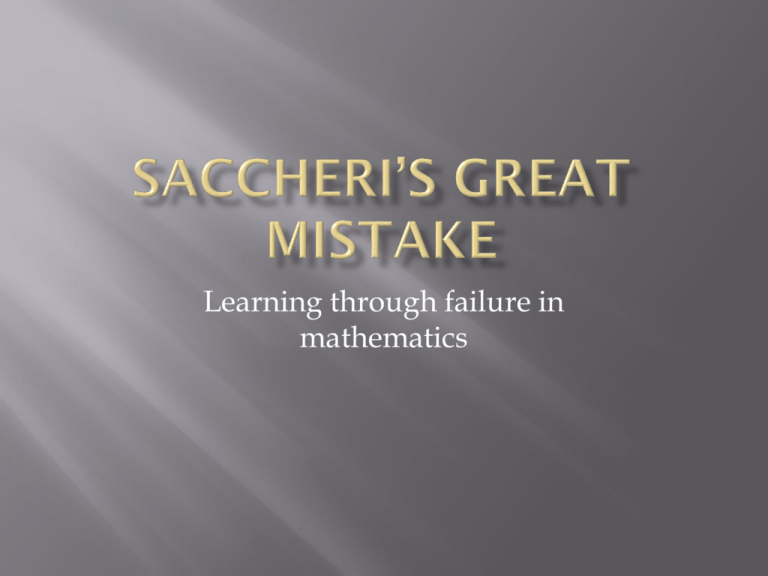
Learning through failure in mathematics Around 300 B.C., Euclid began work in Alexandria on Elements, a veritable “bible of mathematics” Euclid set up an axiomatic system upon which propositions are proven using deductive reasoning The foundation was just 23 definitions, 5 postulates, and 5 general axioms The end result was 13 books of 465 propositions Though little of the work in Elements was unchartered mathematics, the beauty and simplicity in logic of the axiomatic system that Euclid created has made Euclid one of the bestknown mathematicians ever 1. A straight line segment can be drawn joining any two points. 2. Any straight line segment can be extended indefinitely in a straight line. 3. Given any straight line segment, a circle can be drawn having the segment as radius and one endpoint as center. 4. All right angles are congruent. 5. If two lines are drawn which intersect a third in such a way that the sum of the inner angles on one side is less than two right angles, then the two lines inevitably must intersect each other on that side if extended far enough. This postulate is equivalent to what is known as the parallel postulate. Also known as the Parallel Postulate Clearly a far longer and more complex postulate than any of the other four postulates Though “it was universally agreed that the postulate was a logical necessity,” many felt it could be derived from the first four postulates and thus should have been a proposition The debate raged on for centuries as mathematicians tried and failed to prove it Saccheri was one such mathematician convinced in his gut that Euclid’s Parallel Postulate was not independent of the other four Though about 2,000 years had passed since Euclid authored Elements, Saccheri pressed on While many mathematicians had attempted to directly prove the Parallel Postulate using the other four postulates, Saccheri had a different approach He built upon the work of Nasir Eddin (one of Genghis Khan’s many grandchildren) nearly 500 years earlier Eddin and Saccheri studied quadrilaterals (now known as Saccheri quadrilaterals) and looked to prove the Parallel Postulate using a proof by contradiction A Saccheri Quadrilateral has congruent sides that are perpendicular to the base Using congruent triangles, we see that the “summit angles” must be congruent Critically, this could be proven without the use of Euclid’s Parallel Postulate These summit angles must then both be either obtuse, right, or acute Consider the three cases for the summit angles of the Saccheri quadrilateral If summit angles are obtuse, that would imply zero parallel lines If summit angles are acute, that would imply more than one parallel line If summit angles are right, there is exactly one parallel line Saccheri’s aim was to show that the first two scenarios were impossible, and thus prove that Euclid’s Parallel Postulate is unnecessary The Saccheri-Legendre Theorem states that “The sum of the measures of the angles of any triangle is less than or equal to 180 degrees.” A corollary of this result in neutral geometry (and thus without the use of Euclid’s Parallel Postulate) is that the angle sum of any convex quadrilateral is less than or equal to 360 degrees. A Saccheri quadrilateral with obtuse summit angles clearly contradicts this corollary, and thus we can rule out the case. Saccheri was just one step from his goal of proving that Euclid’s Parallel Postulate was unnecessary! Saccheri now set out to find a contradiction assuming the summit angles were acute Unfortunately (or was it?), he found that he was able to derive many of Euclid’s propositions while using this assumption Unable to find a contradiction, Saccheri nonetheless published a book called “Euclid Freed of Every Flaw,” and in it stated under Proposition XXXIII: The hypothesis of acute angle is absolutely false; because repugnant to the nature of the straight line. Not surprisingly, mathematicians were not convinced by this argument After publishing “Euclid Freed of Every Flaw,” Saccheri went on to publish another work to convince mathematicians of his claim Regardless, to his great dismay, Saccheri died having neither proven nor disproven the need for Euclid’s Parallel Postulate Despite Saccheri’s failure, he had actually laid much of the groundwork for an entire world of unexplored geometries, non-Euclidean geometry So, Euclid’s 5th Postulate was necessary for Euclidean geometry, but Euclid’s geometry was not the only possibility The most easily visualized branch of non-Euclidean geometry is spherical geometry Earth, with its lines of latitude and longitude, is an excellent model Other branches also exist, including hyperbolic and elliptic geometry The history of mathematics is littered with long stretches of failure by bright minds to prove or disprove various propositions Saccheri provides a great example of why we should avoid allowing our own preconceptions to distract us from deductive logic Despite these failings, much of the work that takes place along the journey serves to further understanding in the field Had Saccheri recognized the implications of his work, he could have become the “father of non-Euclidean geometry” Finally, students will be relieved to see that even the brightest minds struggled immensely “Journey through Genius: The Great Theorems of Mathematics” by William Dunham (1991) http://www.cut-the-knot.org/triangle/pythpar/Attempts.shtml http://en.wikipedia.org/wiki/Giovanni_Girolamo_Saccheri http://mathworld.wolfram.com/EuclidsPostulates.html http://www.learner.org/courses/mathilluminated/units/8/text book/03.php http://en.wikipedia.org/wiki/File:Saccheri_quads.svg http://www.wcfchess.org/wp/hall-of-fame/ http://en.wikipedia.org/wiki/File:Noneuclid.svg http://en.wikipedia.org/wiki/File:Triangles_%28spherical_geom etry%29.jpg
